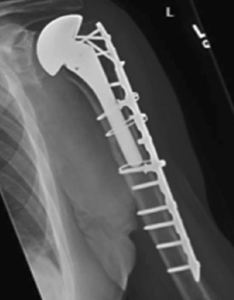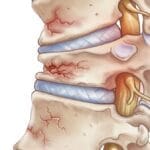Overview:
Periprosthetic humeral fractures occur around implanted hardware, such as after total shoulder arthroplasty (TSA) or reverse shoulder arthroplasty (RSA). Proper assessment and treatment depend on the stability of the implant and the fracture pattern.
What are Periprosthetic Humeral Fractures?
These fractures happen around the shoulder implants, either during surgery (intraoperative) or after surgery (postoperative).
Causes of Periprosthetic Humeral Fractures:
- Intraoperative Factors: Issues during surgery, such as excessive force or improper implant placement.
- Postoperative Factors: Falls or other trauma after surgery, combined with patient factors like age and bone quality.
Symptoms:
- Pain: Severe pain around the shoulder.
- Swelling and Deformity: Visible swelling and possible deformity.
- Limited Movement: Difficulty moving the arm.
Diagnosing Periprosthetic Humeral Fractures:
- Physical Examination: Checking for pain, swelling, and deformity.
- Imaging:
- X-rays: Standard views to assess the fracture and implant.
- CT Scans: For detailed assessment.
Types of Fractures:
- Campbell and Wright Classification: Considers fracture displacement and implant stability.
- Cofield Classification: Focuses on the implant and surrounding bone stock.
Treatment Options:
- Non-Surgical Management:
- Suitable for stable implants with minimal fracture displacement.
- Immobilisation: Using a sling or brace to support the arm.
- Healing Time: Typically takes 3.5 to 6 months.
- Surgical Management:
- Needed for unstable or displaced fractures.
- ORIF (Open Reduction and Internal Fixation): Aligning and fixing the bones with plates and screws.
Revision Shoulder Arthroplasty: Replacing or adjusting the implant for better stability
Possible Complications:
- Infection: Risk after surgery.
- Implant Failure: Problems with the shoulder implant.
- Non-Union: Bone fails to heal.
Lessons Learned:
- Accurate assessment of risk factors and fracture mechanisms is crucial.
- Non-surgical treatment works for stable fractures.
- Surgery is necessary for unstable or displaced fractures.
- Regular follow-up and imaging are essential for monitoring healing and detecting complications.






